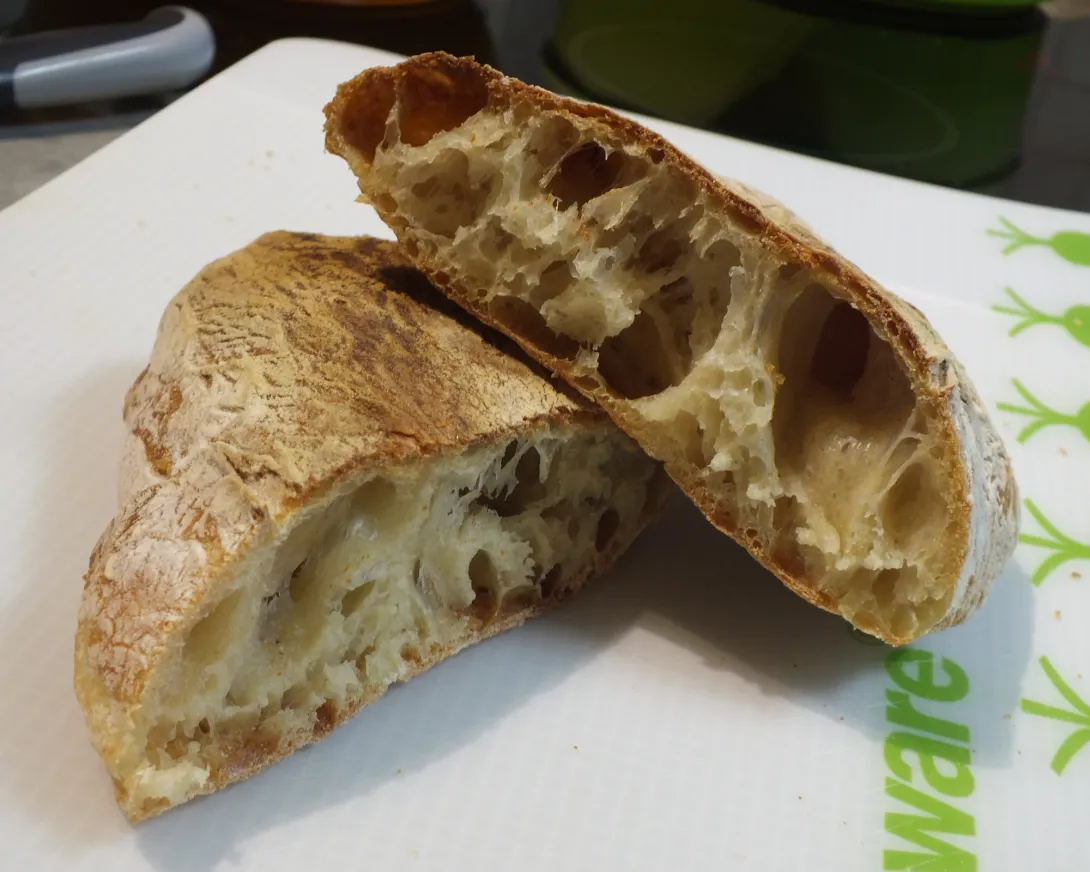
Hello all, this is my first post over here :)
Iv'e been learning from this site for a long while now, and thought it's time to start posting the results.
This is my third or so attempt at baking a sabbatical with the goal of creating a nice, open, crumb - and I think I've finally nailed it.
The recipe is based at the recipe from "Baking Artisan Bread" by Ciril Hitz.
Made a 1:1 poolish and left it to ferment 16 hours overnight.
Final dough:
- Bread flour 100%
- Cold water 66%
- Yeast 1%
- Salt 3%
- Poolish (1:1) 107%
Hydration of final dough is 77%
Mixed poolish with yeast, most of the water (85% of them), and a few tablespoons of the flour - until aerated.
Added rest of flour and kneaded in mixer for a few minutes, until a sticky but formed and homogeneous dough was formed.
Left to autolyse for 30 min.
Added salt and kneaded in mixer for 13 minutes, during which I've slowly incorporated the leftover water. Dough should be somewhat developed by now.
Poured sticky dough into an oiled oven sheet. Left to rest (covered) for 25 min.
Preformed a double stretch and fold sequence. Left to rest for another 25 minutes
Repeat until 4 double S&Fs where preformed. Finish with 25 minute rest.
Flour top of dough and work surface with lots of flour.
Flipped dough and let fall from oven sheet onto the working surface.
Flipped half of dough over itself and floured it's top.
cut dough into apx 220g pieces.
cut a thin strip of dough from each piece and stick it on top of it (this will result in a weak spot that will allow the bread to expend without the need of scoring the sticky dough).
Flip the dough pieces onto a well floured couche. Flour top part of dough.
Cover and let proof for about 20 min (use finger pocking test).
Flip pieces again and place on a baking steel, placed in the middle of a super hot oven (I've preheated mine for an hour with broiler on max).
Poured a cup of hot water into a pan at the bottom of the oven. Spray oven walls with water.
Baked for 7 minutes, until oven spring has ended, and the breads no longer expand.
Reduce thermostat to 250 deg C, open oven and remove steam pan.
Continue baking for 10 to 15 minutes with oven door slightly open - until crust is browned to your preference. Bread inner temp should be at least 98 deg C (100 deg in my case).
Turned of oven heating and left to cool in oven with convection on for 10 minutes. (I've flipped the breads on their tops, so that the bottom won't continue baking from the steel leftover heat).
Remove excess flour from bread crust.
Crumb was open, soft and tasty.
Crust a little to dark and hard to my liking (Iv'e managed to injure my inner cheek...).
Taste was good for a lean yeasted bread, but I would like to improve it.
Made awesome sandwiches with some moldy cheese and fresh vegetables.
Thank you for reading, I'll appreciate feedback!
- Shai
- Shai's Blog
- Log in or register to post comments
Shai Noy: You really did nail it! These look fantastic. I have made lots of breads, but not the ciabatta yet. Maybe I will try your recipe. I would be interested in the comments on your technique with the strip. Love the crumb! Congratulations on this bread and your first post! Best, Phyllis
Thank you very much!
The technique is from Ciril Hitz, as seen on this video (at 10:42).
He makes a very good demonstration of the entire bread making process in this video.
The idea is that with such a slack dough, scoring can be a real pain, and even make the sough collapse. By placing this strip of dough on top of it, we create a single week spot (or more precisely a line) for the bread to expend at, much like with scoring.
The result is not as elegant as with traditional scoring, but it fits the ciabatta rustic look quite well.
Welcome to TFL. Your ciabatta looks great! I also enjoy watching the Ciril Hitz videos. He's a good teacher.
:) Mary
I DO NOT UNDERSTAND YOUR FORMULA --- COULD YOU PLEASE SEND YOUR FORMULA IN GRAMS AS I DO NOT UNDERSTAND THE BAKERS PERCENTAGE --- I REALLY WANT TO MAKE THIS BREAD --- DID YOU ALSO COOK IT IN A CONVECTION OVEN USING THE CONVECTION --- I HAVE A VOLLRATH OVEN WHICH IS CONVECTION ALL THE TIME --- THNKS FOR YOUR HELP ---
SLKIRK
First thing, I suggest that you will take some time to learn how to use baker's percentage, it sure will help you in future baking. Try the guide at King Arthur.
Second, Iv'e never tried using convection during the baking stage itself, I've only used it while cooling the bread. I assume that it should work, however you need to make sure that the bread doesn't brown too quickly before it's center is fully set. If you can, measure the bread's inner temperature after 10-15 minutes of baking and adjust heat accordingly.
The recipe in grams:
For poolish:
For final dough:
Happy baking!
Shai